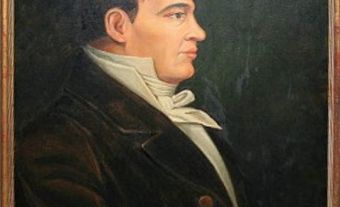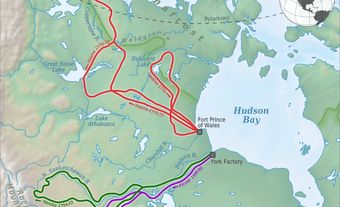
Antoine Laumet, known as “de Lamothe Cadillac,” explorer, seigneur in Acadia, commandant of Fort Michilimackinac, founder of Detroit and of the first colony in Ontario, governor of Louisiana (born 5 March 1658 at Saint-Nicolas-de-la-Grave, France; died 16 October 1730 at Castelsarrasin, France).
Origins and Early Career
Little is known about Cadillac before his arrival in Canada about 1683. After landing in Acadia, he settled in Port Royal (Nova Scotia). Cadillac then served for a few years on a ship captained by the privateer François Guyon (Guion), who was responsible for the defence of the Acadian coasts against British ships. When in the city of Québec, Cadillac frequently visited the Guyon family and, in 1687, he married François’ niece, Marie-Thérèse Guyon. At the time of his marriage, Cadillac lied about his origins by claiming that he was “Antoine de la Mothe, horseman, sieur (esquire) de Cadillac, 26 years of age, son of Jean de la Mothe, seigneur (lord) of the said Cadillac, of Launay and of Montet, counsel to the Parliament of Toulouse, and [son] of Lady Jeanne de Malenfant” [trans.]. In fact, his family never possessed any seigneurie and his parents did not belong to the nobility. His father, Jean Laumet, was a minor provincial magistrate and his mother, who was actually called Jeanne Péchagut, came from a middle-class family.
In 1688, Cadillac returned to Acadia, and the Marquis of Denonville, governor of New France, granted him the seigneurie of Douacques (which became the city of Bar Harbor in the state of Maine). He settled there, but in 1690 his house was destroyed by William Phips’ army during the attack on Port Royal. The following year, Cadillac returned to Québec, and Frontenac took him on as lieutenant of the Troupes de la Marine (the colonial regular troops). In 1693, after submitting a detailed report on the topography of New England with the cartographer Jean-Baptiste-Louis Franquelin, Cadillac was promoted to the rank of captain. In 1694, Cadillac became commandant of Fort de Buade (also known as Fort Michilimackinac), which was located at the junction of Lake Huron and Lake Michigan. This military and commercial post was of crucial importance because of the war with the Iroquois that was raging at that time. However, Cadillac was more interested in the fur trade and in selling alcohol than in military strategy, and he proved to be a poor commandant.
The Colony at Detroit
Cadillac left for France in 1698 to submit to his grand plan for colonizing the area in New France known as the Pays-d'en-Haut, the “back country” where the voyageurs travelled to trade. The spot that Cadillac chose for the colony was situated along a strait, a narrow waterway that connects two bodies of water (now known as Lake Erie and Lake St. Clair). In writings from that time, reference was made to the “détroit,” and this is why the strait later became known as the Detroit River.
What Cadillac hoped to establish was not a fort like the one he had commanded at Michilimackinac, but a small French colony instead. The French naval minister, Jérôme Phélypeaux, Comte de Pontchartrain, gave approval for the project in 1700. Cadillac left Montréal on 5 June 1701, and it took nearly two months to reach the strait. He arrived on 24 July, accompanied by his first lieutenant Alphonse de Tonty, the Récollet Constantin Delhalle and the Jesuit François Vaillant de Gueslis, as well as 50 soldiers and 50 settlers. Cadillac built Fort Pontchartrain (the future city of Detroit) on the north bank, and, in 1744, a mission (see Missions and Missionaries) was founded on the south bank of the Detroit River (the future city of Windsor).
However, Cadillac’s ambition did not stop there. He asked that western outposts be granted the right to self-government, but his proposal was opposed by the governor of New France, Philippe de Rigaud de Vaudreuil, and became a source of conflict between the two men. In 1708, a report submitted to Minister Pontchartrain showed that the colony established by Cadillac had not achieved the promised results. In seven years, it had attracted only 62 settlers, and only 353 acres of land had been cleared. Moreover, far from strengthening the ties between the French and the Aboriginal peoples of the west, Cadillac’s policies had led to violent confrontations between the various groups (the Huron, the Odawa and the Miami) that had settled at the strait. In addition, the presence of the fort had no impact on the flow of furs to New York.
In short, the colony of Detroit did not develop significantly under Cadillac`s command. Although the project was Cadillac’s idea, it was the action taken by governor La Galissonière in 1749 — almost 50 years later — that encouraged colonization along the strait. In 1710, Cadillac was named governor of Louisiana, the poorest of the French colonies. He did not arrive there until 1713, when he quarrelled with the colony’s ordonnateur (who served the same function as an intendant in Canada). Cadillac was recalled to France in 1716, and he embarked on the crossing in the summer of 1717. In 1723, he purchased the post of governor of Castelsarrasin, a small town near the village where he was born. He died in Castelsarrasin on 15 October 1730.
Cadillac: Exalted Hero, Complete Scoundrel or Unsung Father of French Ontario?
Historians have mixed feelings about Cadillac. Agnes Laut considers him “one of the few great early heroes in North American History,” while William John Eccles refers to him as “one of the worst scoundrels ever to set foot in New France.” The truth probably lies somewhere in between.
Gaétan Gervais and Michel Bock, both Franco-Ontarian historians, bemoan the fact that Cadillac “did not live up to his mission” [trans.]. However, they recognize that “Detroit was the first permanent colony in the Pays-d’en-Haut” [trans.]. Gervais and Bock admit that Cadillac was not the most ethical man, that he was only interested in his own personal gain when engaging in trade with the English in New York, and that his interactions with Aboriginal peoples and missionaries were disastrous. Nonetheless, they consider him a primary figure in the colonization of Detroit. In contrast, Robert Choquette is more critical of Cadillac’s legacy, maintaining that the Assomption du Détroit (a mission founded in 1744 on the site of what is now Windsor) was “the first permanent French colony in Ontario that has survived to this day” [trans.].
Nevertheless, it is fair to say that Cadillac’s accomplishments exceeded those of his predecessors who founded Fort Frontenac in Kingston, Fort Conti on the Niagara River, and Fort de Buade, for it was Cadillac’s vision that spurred the colonization of the West. The settlers who accompanied him were not long in discovering and clearing the fertile land along the south bank of the Detroit River. Many pioneer families from southwestern Ontario, including the Chauvin, Janis, Campeau, Renaud, Rivard, and Réaume families, settled in this area. It is also the location of the first parish (1767) and the first school (1786) in Ontario. Cadillac, the unsung father of French Ontario, certainly has a long legacy.

 Share on Facebook
Share on Facebook Share on X
Share on X Share by Email
Share by Email Share on Google Classroom
Share on Google Classroom


